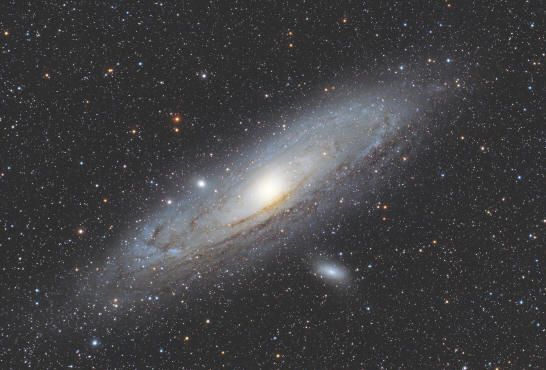The waxing crescent moon will be passing four degrees north of Saturn low in the SW twilight on November 2nd, then seven degrees north of Venus on November 3rd. On Sunday, November 6th, we fall back to CST at 2 a.m., so set your clocks back an hour. On the same evening, the waxing crescent moon passes five degrees north of Mars, now fading
rapidly. The first quarter moon is on November 7th.
The Full Moon on November 14th is the "Frosty Moon" in Indian sky lore, and is certainly a "super moon" for us, with the moon also at perigee, its closest approach to earth in the last 30 years. It is therefore closer and larger than many of you have ever seen it before; can you tell the difference? The Full moon will interfere with the
peak of the Leonid meteor show the following morning. On November 21, the last quarter moon will be rising at midnight. The waning crescent moon will pass two degrees north of Jupiter in the dawn sky on November 25th. The New Moon will be on November 29th.
While the naked eye, dark adapted by several minutes away from any bright lights, is a wonderful instrument to stare up into deep space, far beyond our own Milky Way, binoculars are better for spotting specific deep sky objects. For a detailed map of northern hemisphere skies, about October 31st visit the www.skymaps.com website and
download the map for November 2016; it will have a more extensive calendar, and list of best objects for the naked eyes, binoculars, and scopes on the back of the map.
It is not a good month to spot the planets in the evening sky; catch Saturn right after sunset, low in the SW north of Antares in Scorpius; Saturn is lost in the sunís glare by midmonth. Venus dominates the SW sky after sunset and pulls farther away from the sun and higher in the SW sky all month; it now appears as a featureless gibbous
disk telescopically. Mars is moving eastward in Capricornus, but fading all month. It will be lost in the sunís glare in early 2017. Jupiter is rising about 5 AM as November begins in Virgo, and dominates the dawn skies for the next several months.
Setting in the southwest is the teapot shape of Sagittarius, which marks the heart of our Milky Way Galaxy, but the best view of our Galaxy lies overhead now. The brightest star of the northern hemisphere, Vega dominates the sky in the northwest. To the northeast of Vega is Deneb, the brightest star of Cygnus the Swan. To the south is
Altair, the brightest star of Aquila the Eagle, the third member of the three bright stars that make the Summer Triangle so obvious in the NE these clear autumn evenings. Use binocs and your sky map to spot many clusters here, using the SkyMap download to locate some of the best ones plotted and described on the back.
Overhead the square of Pegasus is a beacon of fall. South of it is the only bright star of Fall, Fomalhaut. If the southern skies of Fall look sparse, it is because we are looking away from our Galaxy into the depths of intergalactic space.
The constellation Cassiopeia makes a striking W, rising in the NE as the Big Dipper sets in the NW. Polaris lies about midway between them. She contains many nice star clusters for binocular users in her outer arm of our Milky Way, extending to the NE now. Her daughter, Andromeda, starts with the NE corner star of Pegasusíí Square, and goes
NE with two more bright stars in a row. It is from the middle star, beta Andromeda, that we proceed about a quarter the way to the top star in the W of Cassiopeia, and look for a faint blur with the naked eye. M-31, the Andromeda Galaxy, is the most distant object visible with the naked eye, lying about 2.5 million light years distant. This monthís feature photo
was shot with an 8" telescope shows many dust lanes and the two companion galaxies, M-32 and M-110.

To the northeast, Andromedaís hero, Perseus, rises. Perseus contains the famed eclipsing binary star Algol, where the Arabs imagined the eye of the gorgon Medusa would lie. It fades to a third its normal brightness for six out of every 70 hours, as a larger but cooler orange giant covers about 80% of the smaller but hotter and thus brighter
companion as seen from Earth. Check it out on a clear November evening, and see it the gorgon is winking at you. If so, then instead of being as bright as Polaris, Algol fade to be only as bright as kappa Persei, the star just to its south. Look at Perseusí feet for the famed Pleiades cluster to rise, a sure sign of bright winter stars to come. In fact, yellow
Capella, a giant star the same temperature and color as our much smaller Sun, rises at 7 PM as November begins along the northeastern horizon. It is the fifth brightest star in the sky, and a beacon of the colorful and bright winter stars to come.